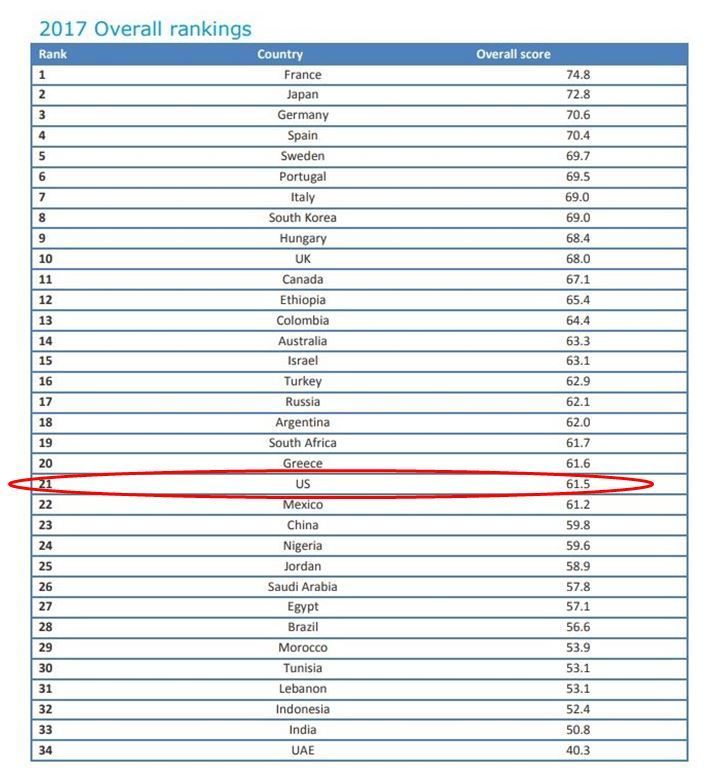Mounting food waste, unsustainable farming practices and rising obesity mean that the US ranks only 21st (out of 34 countries) in the 2017 edition of the Food Sustainability Index (FSI). The country languishes in 24th place in the FSI's nutritional challenges pillar, dragged down by elevated levels of meat, saturated fat and sugar consumption. In sustainable agriculture the US is only 31st, owing to high levels of greenhouse gas emissions from agriculture and large amounts of land devoted to biofuel production and animal feed. Its performance in food loss and waste is slightly better (ranked 9th) amid a commitment to halving food loss and waste by 2030.
In principle, a wealthy country should be capable of ensuring that all of its citizens have access to nutritious and balanced diets. This is patently not the case for the US at present, as underlined by the latest results of the FSI, developed by The Economist Intelligence Unit with the Barilla Center for Food & Nutrition. The FSI places the US in 21st position (out of 34 countries) in terms of overall food sustainability. This means the country significantly underperforms other high-income countries such as top-ranked France, Japan and Germany.

Nutritional challenges
On nutritional challenges (one of three components of the FSI), the US languishes in 24th place amid elevated levels of meat and saturated fat consumption. At 225.4 g per day, average per-head consumption levels of meat in the US are among the highest in the world. Moreover, the sugar content of diets is the highest among the 34 countries in the study. As a result, the prevalence of overweight children (42%) is also the highest.
In response to unhealthy diets, much tougher policy in areas such as food labeling, subsidies on fruits and vegetables, and taxes on sugary drinks could be considered. Campaign groups, such as the Center for Science in the Public Interest (CSPI), are calling on the authorities to adopt a much more robust stance on tackling nutritional problems. According to the CSPI president, Peter Lurie, the Food and Drug Administration's recent decision “to cave in to food industry demands” in delaying the introduction of new food labeling requirements could end up harming public health.
Unsustainable agriculture
High meat consumption is also directly linked to unsustainable agricultural practices, with the rearing of livestock putting pressure on water resources and the climate via greenhouse gas (GHG) emissions. Around 14.5% of the world’s GHG emissions come from livestock, according to the UN’s Food and Agriculture Organization. In addition, rearing livestock places an enormous strain on the world’s water resources: it takes around 15,000 liters to produce a kilogram of beef (or around 1,500 gallons of water to produce one pound of beef).
The US achieves a dismal 31st place for sustainable agriculture; only India, Tunisia and the UAE achieve lower scores under this particular heading. This reflects a number of factors, including a high level of GHG emissions from the agricultural sector, a low proportion of land set aside for organic farming (less than 1% of the total) and a relatively large amount of land (around 22%) devoted to biofuel production and animal feed.
Food loss and waste
By contrast, the US’ performance in food loss and waste is slightly better; the country is ranked 9th in the world thanks to relatively low levels of food loss as a share of total food production (0.8%). The country's policy response to food loss also receives a high score. In line with the UN Sustainable Development Goals, the federal authorities have committed to halving food loss and waste by 2030.
That said, at end-user level the US has one of the highest levels of food waste per head in the world. Around 40% of the food that is produced is destined for landfills. By reducing this waste, officials in the US Department of Agriculture expect more food to be freed up for the 41.2m Americans who currently live in food-insecure households.
For the overall rankings of the FSI 2017 see the table below. More details on the methodology and the full index results by category as well as accompanying reports, infographics and case studies can be found at http://foodsustainability.eiu.com/.

Note: scores are scaled from 0 to 100, where 100 equals the highest sustainability and greatest progress towards meeting environmental, societal and economic Key Performance Indicators.
Source: Economist Intelligence Unit, Food Sustainability Index 2017, http://foodsustainability.eiu.com/.
